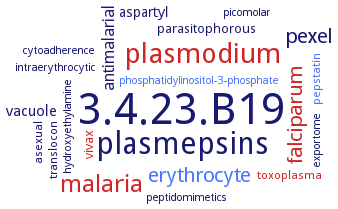3.4.23.B19: plasmepsin V
This is an abbreviated version!
For detailed information about plasmepsin V, go to the full flat file.

Word Map on EC 3.4.23.B19 
-
3.4.23.B19
-
plasmepsins
-
plasmodium
-
malaria
-
falciparum
-
erythrocyte
-
pexel
-
antimalarial
-
vacuole
-
aspartyl
-
parasitophorous
-
vivax
-
translocon
-
pepstatin
-
asexual
-
toxoplasma
-
hydroxyethylamine
-
peptidomimetics
-
phosphatidylinositol-3-phosphate
-
cytoadherence
-
exportome
-
picomolar
-
intraerythrocytic
- 3.4.23.B19
-
plasmepsins
- plasmodium
- malaria
- falciparum
- erythrocyte
-
pexel
-
antimalarial
- vacuole
-
aspartyl
-
parasitophorous
- vivax
-
translocon
- pepstatin
-
asexual
- toxoplasma
-
hydroxyethylamine
-
peptidomimetics
- phosphatidylinositol-3-phosphate
-
cytoadherence
-
exportome
-
picomolar
-
intraerythrocytic
Reaction
cleavage of hemoglobin. In contrast to the food vacuole plasmepsins, detergent-solubilized PM V does not bind the aspartic protease inhibitor pepstatin. =
Synonyms
plasmepsin V, Plm V, PlmV, PM V, PMV, PMVm84, PMVp37
ECTree
Advanced search results
Engineering
Engineering on EC 3.4.23.B19 - plasmepsin V
Please wait a moment until all data is loaded. This message will disappear when all data is loaded.
C178A
the mutant shows reduced activity compared to the wild type enzyme
C178S
the mutant shows increased activity compared to the wild type enzyme
D108A
-
mutation renders expressed protein catalytically inactive. Mutant localizes to the endoplasmic reticulum but the mutant has 3fold reduced signal by immunofluorescence and by western blot. Mutant enzyme-expressing parasites are frequently seen encased in erythrocyte ghosts, suggesting impaired host cell homeostasis. The levels of host erythrocyte histidine-rich protein II and another exported protein, RESA (ring-infected erythrocyte surface antigen), are diminished in the mutated PM V-expressing parasitized erythrocytes by 30-50%. Episomal expression of catalytically dead PM V has a dominant-negative effect on parasite growth and on protein export
D118N
the mutant shows reduced activity compared to the wild type enzyme
D118N/D365N
the mutant shows reduced activity compared to the wild type enzyme
D365N
the mutant shows reduced activity compared to the wild type enzyme
additional information
-
identification of the region responsible for endoplasmic reticulum targeting: full-length PM V-GFP integrants and integrants with deletion of the C-terminus downstream of the membrane-spanning segment have no phenotype and retain endoplasmic reticulum targeting. Deletions involving the membrane anchor are lethal. Fusion of the transmembrane region but not other portions of PM V is sufficient to target a reporter to the endoplasmic reticulum


 results (
results ( results (
results ( top
top






